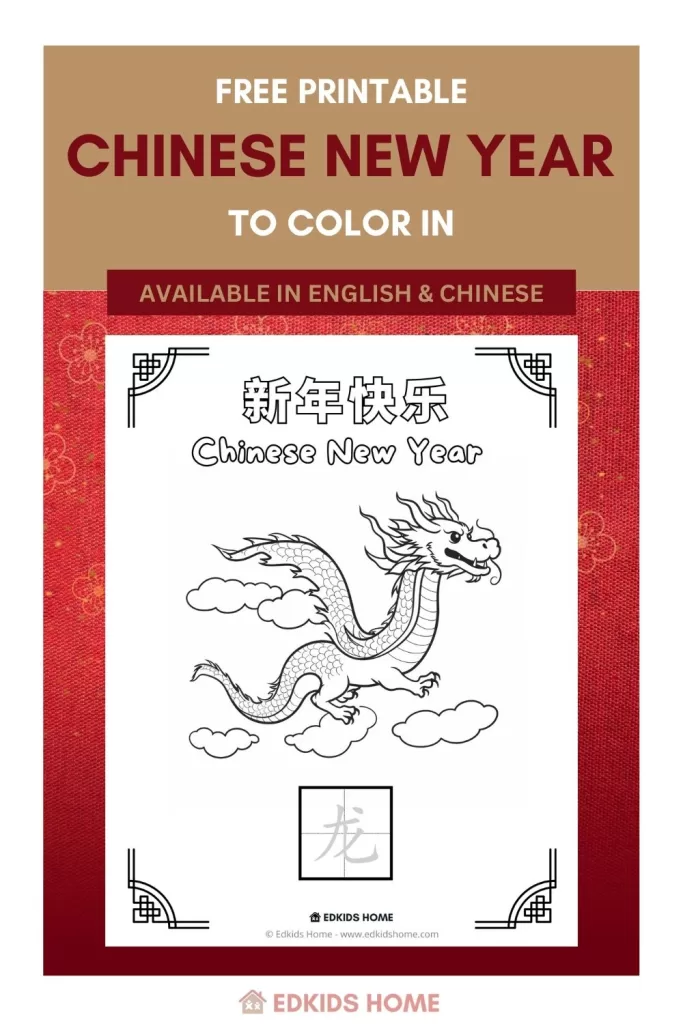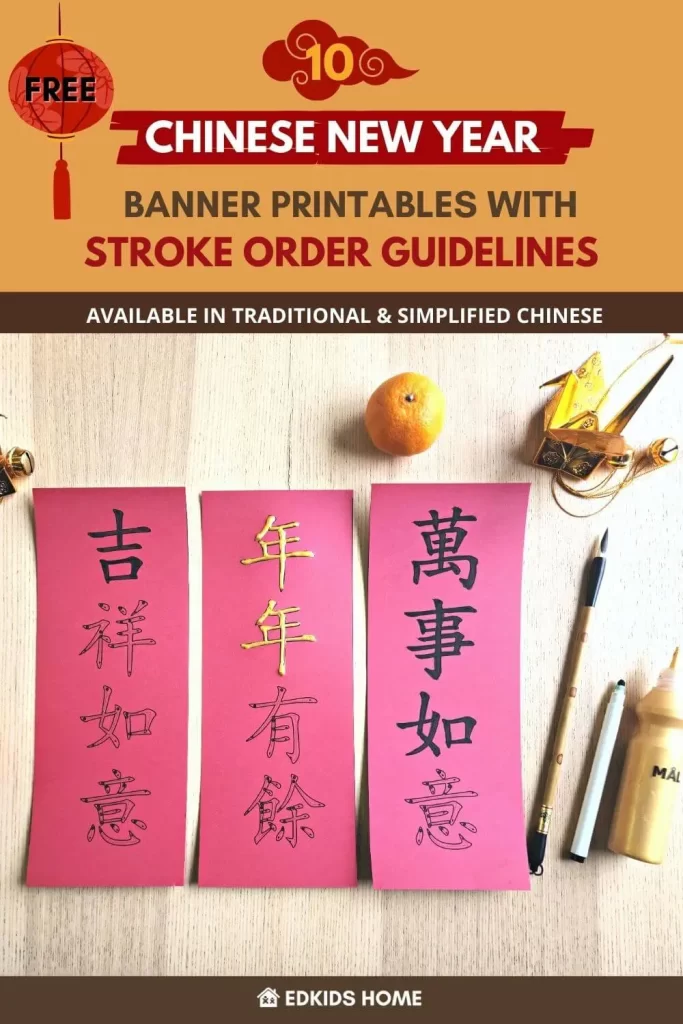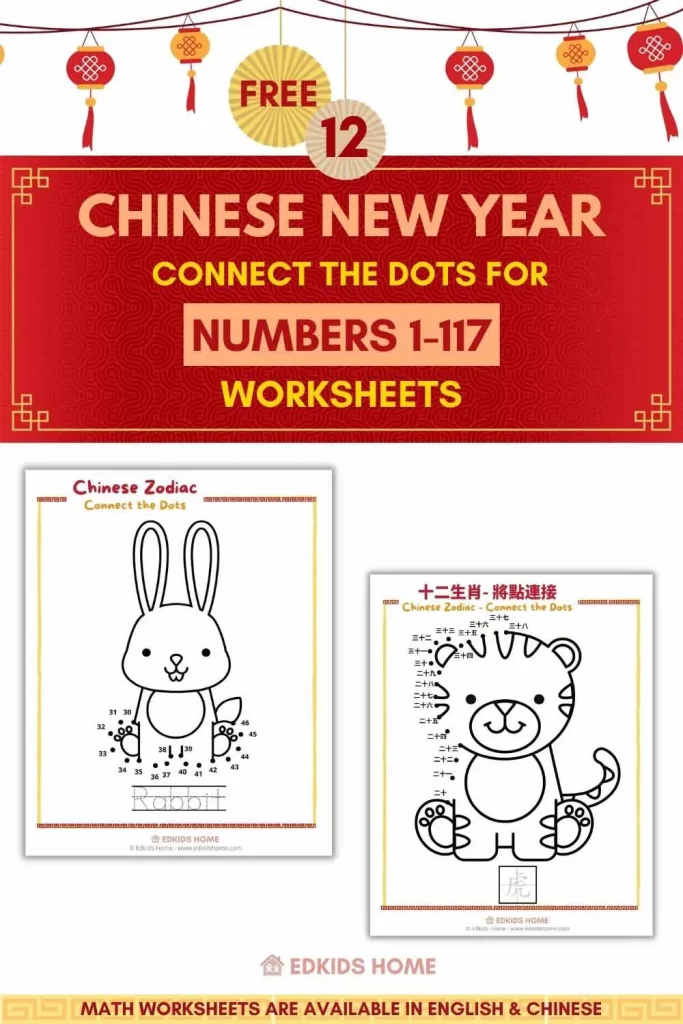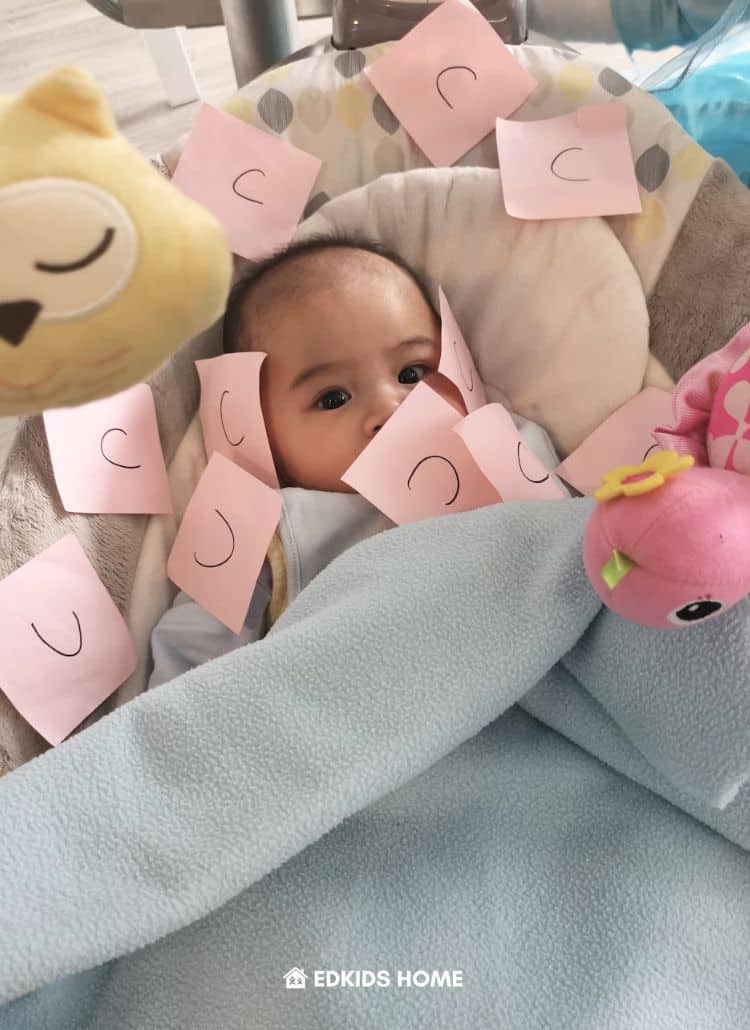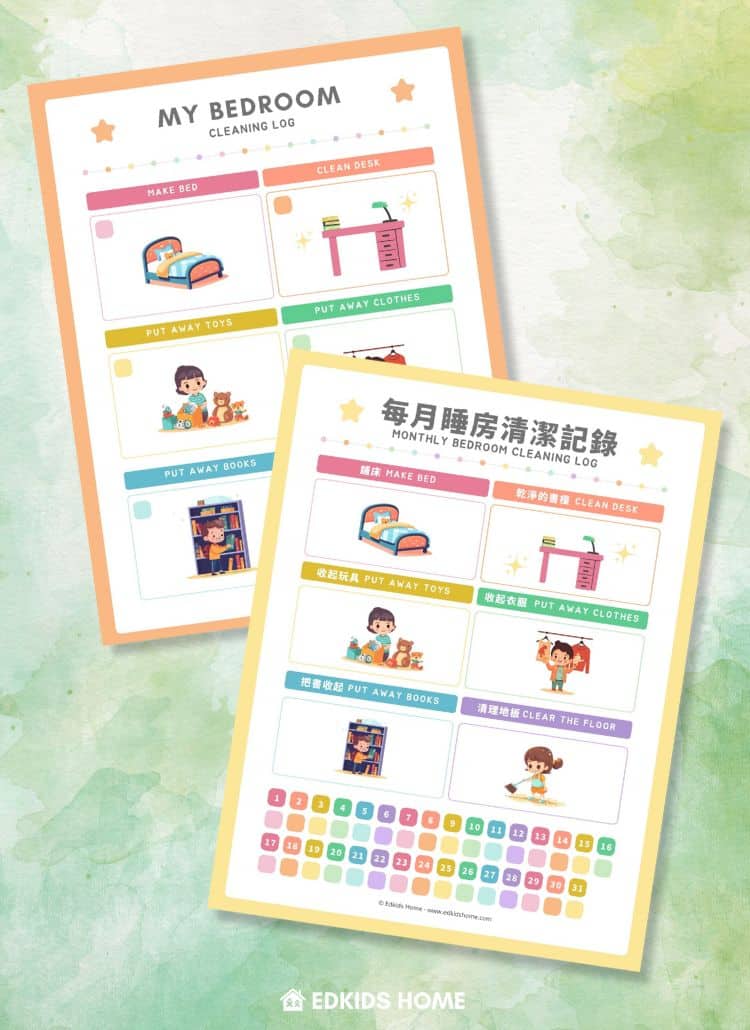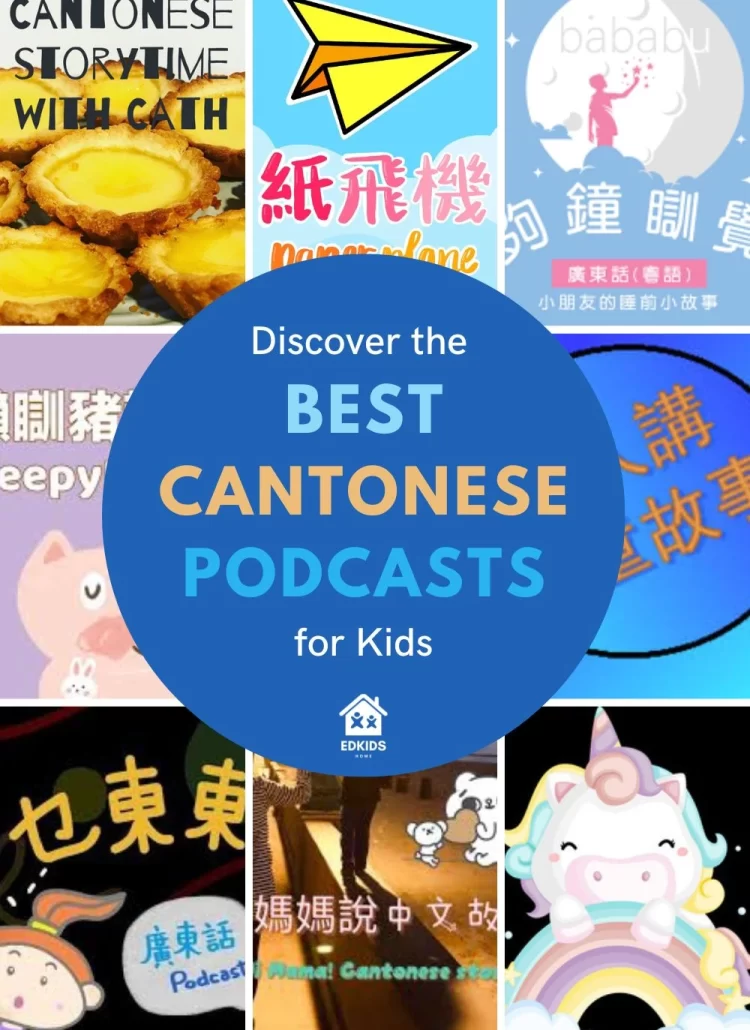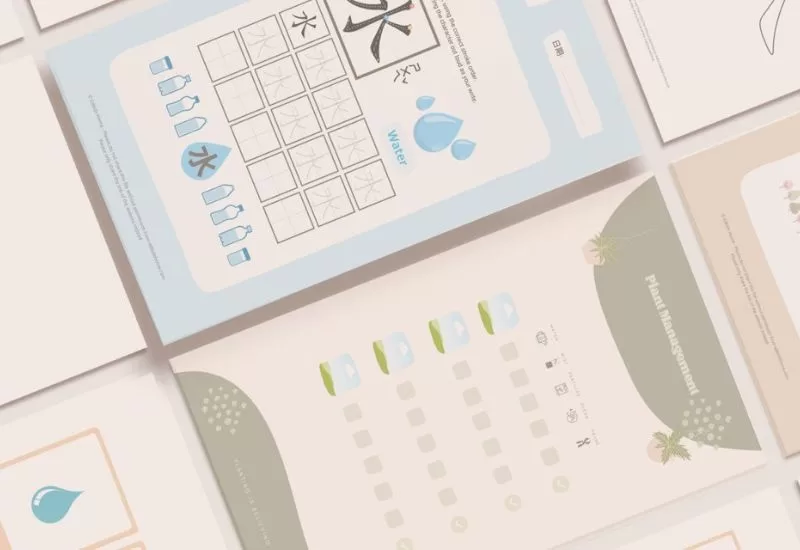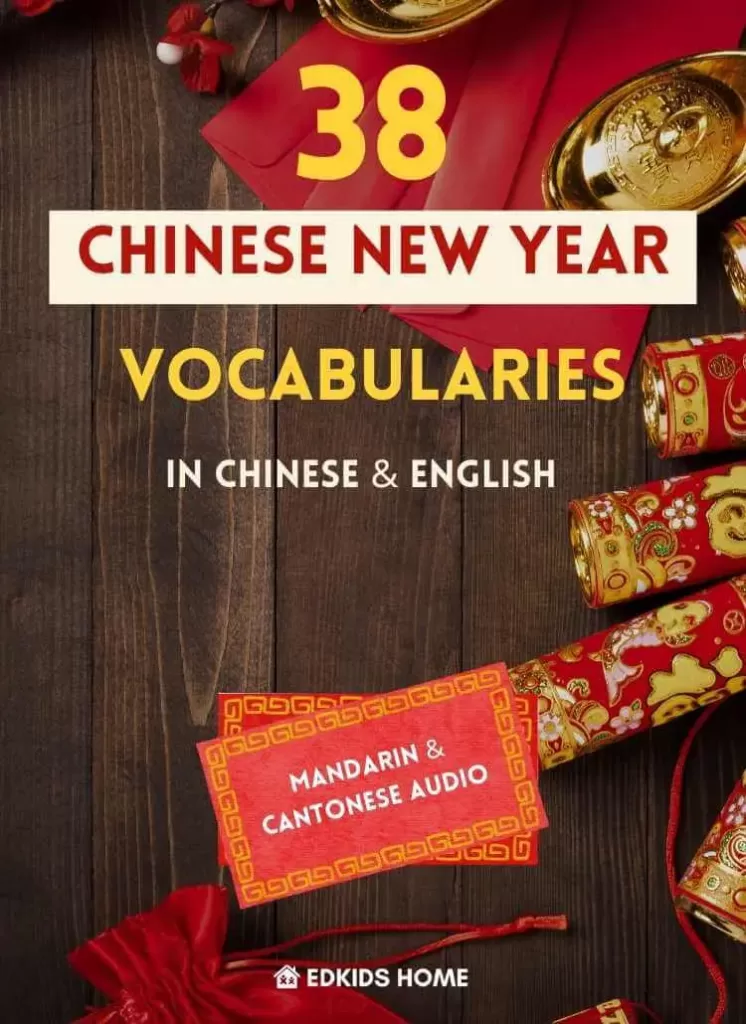
Are you looking to expand your Chinese New Year vocabulary? Look no further! Chinese New Year is one of the most important holidays in the Chinese culture, filled with traditions and blessings for good fortune. Whether you speak Cantonese or Mandarin, we've got you covered with a comprehensive list of 38 essential Chinese New Year vocabulary. With audio and writing guides, you'll be ready to celebrate and understand this festive occasion like never before!
In this blog post, we've compiled a list of 38 Chinese New Year vocabulary available in both English and Chinese (Traditional, Simplified, Pinyin, and Jyutping). We also have audio recordings in Mandarin and Cantonese.
Chinese New Year is such a special time! It's not just about prosperity and renewal – there's so much more to it. Aside from the Hong Kong traditions, I've also had the opportunity to learn about Shanghai traditions from my husband's family. It's like discovering a whole new world of customs and delicious food! This blog post is like a mixtape of different Chinese New Year practices and elements from all over. Just like how I've learned and appreciated Chinese New Year through my husband's Shanghai roots, I hope this vocabulary guide helps you explore the richness of this celebration, whether you're learning Cantonese or Mandarin, Traditional or Simplified Chinese. Let's dive in together!
Related Articles:
- 18 Popular Lunar New Year Greetings & Wishes (2024)
- 12 Wonderful Lunar New Year Activities For Kids (2024)
- Everything You Can Teach Your Kids About Lunar New Year With Videos
38 Chinese New Year Vocabulary
For this list, we have grouped all the vocabulary associated with Chinese New Year into the following three categories:
- Chinese New Year Special events and traditions
- Chinese New Year Objects and Activities
- Chinese New Year Food
Also, check out 18 Popular Chinese New Year Greetings with both Cantonese & Mandarin audio!
Chinese New Year Vocabulary – Special Events and Traditions
Check out these key events and traditions during the Chinese New Year! As we mentioned earlier, these fresh words will give you a great peek into the traditions and how Chinese people celebrate the new year!
1.Spring Festival | 春節
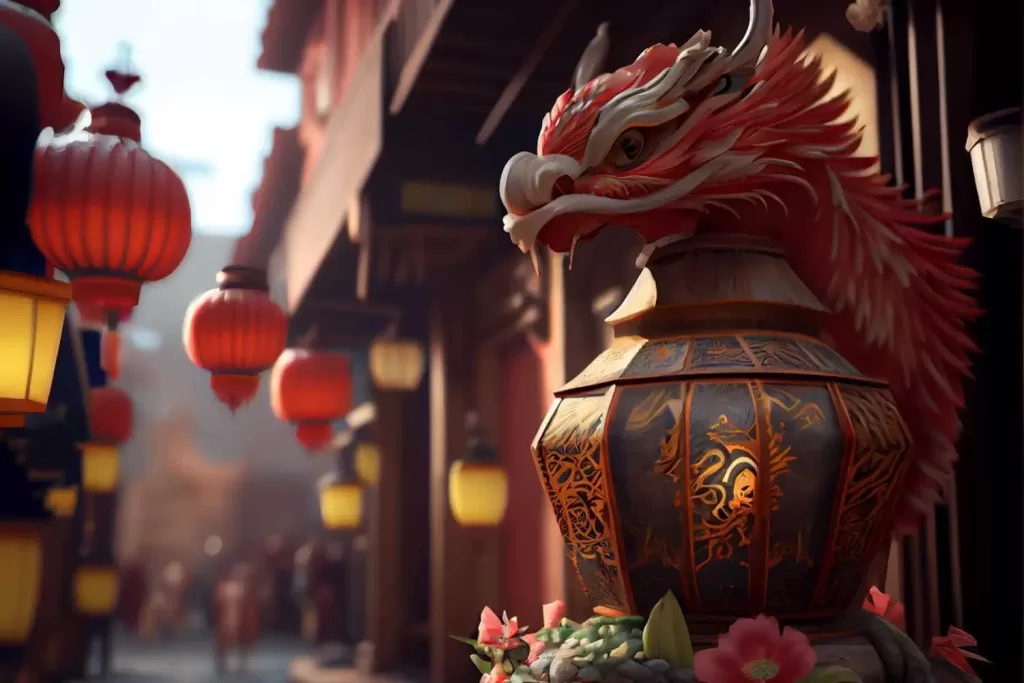
- Traditional Chinese: 春節
- Simplified Chinese: 春节
- English: Spring Festival
Cantonese (ceon1 zit3)
Mandarin (chūn jié)
This refers to the start of the Chinese New Year and is also known as Chinese New Year. It is the most important festival in Chinese culture.
2. Chinese Calendar | 農曆
- Traditional Chinese: 農曆
- Simplified Chinese: 农历
- English: Chinese Calendar
Cantonese (nung4 lik6)
Mandarin (nóng lì)
This is a calendar based on the cycles of the moon, which is used to determine important dates such as Chinese New Year. It is different from the Gregorian calendar used in most countries and also known as the Lunar Calendar.
You can check out the Chinese Calendar from Prokerala.
3. Chinese New Year's Eve | 除夕
- Traditional Chinese: 除夕
- Simplified Chinese: 除夕
- English: Chinese New Year's Eve
Cantonese (ceoi4 zik6)
Mandarin (chú xī)
This refers to the evening before Chinese New Year when families gather for a reunion dinner and stay up late to welcome the new year.
4. New Year's Day | 大年初一
- Traditional Chinese: 大年初一
- Simplified Chinese: 大年初一
- English: New Year's Day
Cantonese (daai6 nin4 co1 jat1)
Mandarin (dà nián chū yī)
This is the first day of the Chinese New Year, which is traditionally spent with family and involves many rituals and customs to bring good luck for the upcoming year.
5. Day After New Year's | 初二
- Traditional Chinese: 初二
- Simplified Chinese: 初二
- English: Day After New Year's
Cantonese (co1 ji6)
Mandarin (chū èr)
This is the second day of the Chinese New Year, which is often spent visiting relatives and friends to exchange greetings and well wishes for the new year.
6. Lantern Festival | 元宵節
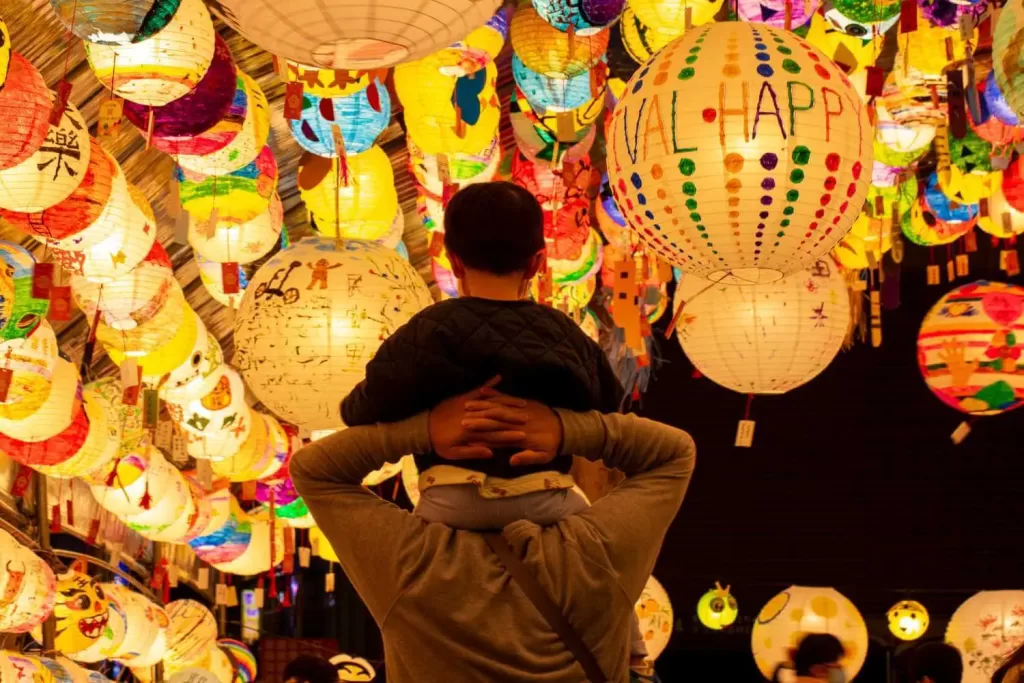
- Traditional Chinese: 元宵節
- Simplified Chinese: 元宵节
- English: Lantern Festival
Cantonese (jyun4 siu1 zit3)
Mandarin (yuán xiāo jié)
This festival is celebrated on the 15th day of the first Chinese month, marking the end of the Chinese New Year celebrations. It is a time for families to gather and enjoy lantern displays, solve riddles on lanterns, and eat sweet glutinous rice dumplings called 湯圓 | 汤圆.
7. Reunion Dinner | 團圓飯
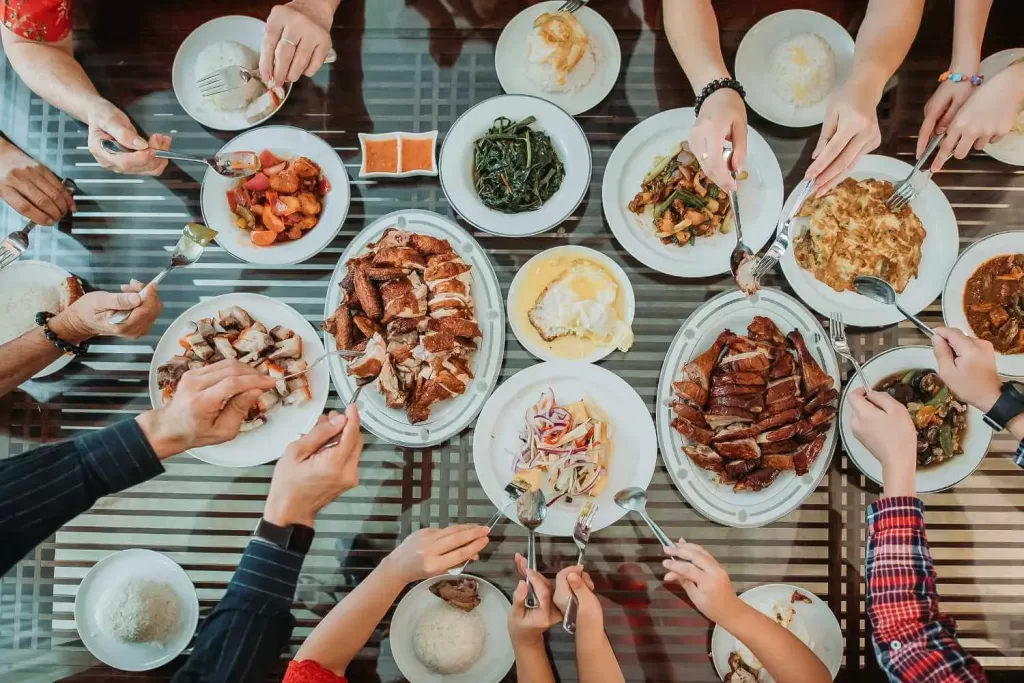
- Traditional Chinese: 團圓飯
- Simplified Chinese: 团圆饭
- English: Family Reunion Dinner
Cantonese (tyun4 jyun4 faan6)
Mandarin (tuán yuán fàn)
This refers to the special dinner held on New Year's Eve, where family members come together to eat, chat, and bond. It is considered the most important meal of the year. Traditional dishes such as fish, dumplings, and spring rolls are served to symbolize good luck and prosperity.
8. Reunion Dinner | 年夜飯
- Traditional Chinese: 年夜飯
- Simplified Chinese: 年夜饭
- English: New Year's Dinner
Cantonese (lin4 je6 faan6)
Mandarin (nián yè fàn)
This is another name for the family reunion dinner, and it is also sometimes called “Reunion Dinner” or “Gathering Dinner.” It typically includes dishes with auspicious meanings like whole fish for abundance, dried oysters for good fortune, and 年糕 (sticky rice cake) for a higher income.
9. New Year's Visit | 拜年
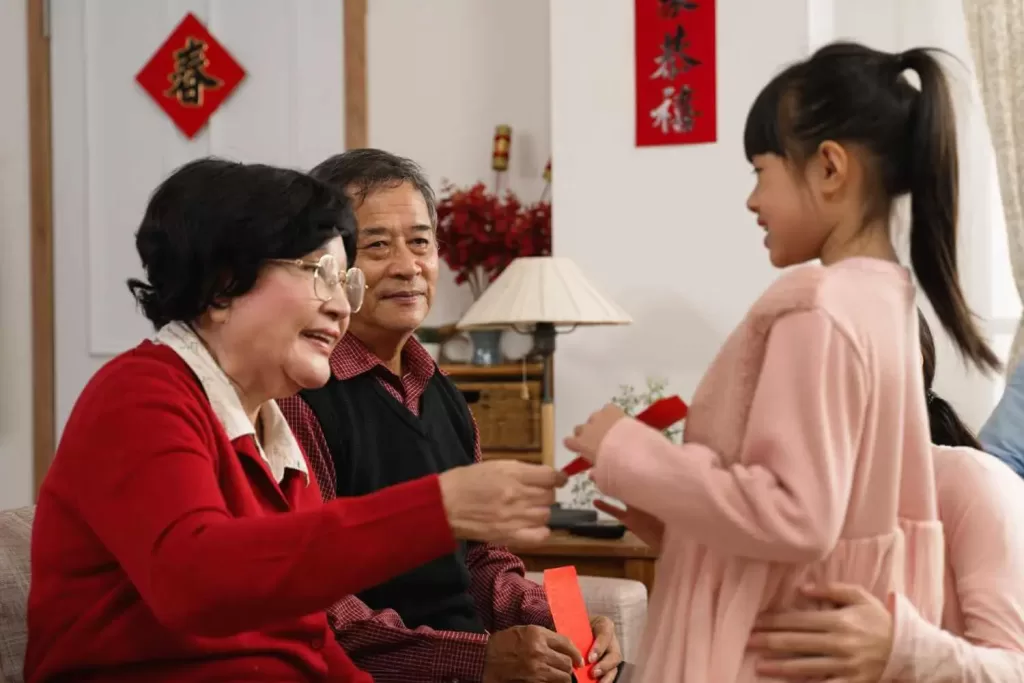
- Traditional Chinese: 拜年
- Simplified Chinese: 拜年
- English: New Year's Visit
Cantonese (baai3 nin4)
Mandarin (bài nián)
During the first few days of the new year, it is customary to visit friends and relatives to wish them a happy new year, give blessings, and exchange red envelopes (hongbao). This is an important tradition that strengthens relationships and helps spread good fortune for the coming year.
10. Celebrate the New Year | 過年
- Traditional Chinese: 過年
- Simplified Chinese: 过年
- English: Celebrate the New Year
Cantonese (gwo3 nin4)
Mandarin (guò nián)
This phrase means to celebrate or observe the new year. It encompasses all the traditions and customs associated with the holiday, such as preparing decorations, cleaning the house, and spending time with family. It is a time for reflection, gratitude, and setting intentions for the upcoming year.
11. New Year's First Meal | 開年飯

- Traditional Chinese: 開年飯
- Simplified Chinese: 开年饭
- English: New Year’s First Meal
Cantonese (hoi1 nin4 faan6)
Mandarin (kāi nián fàn)
This is a special meal eaten on the first day of the new year, and it is believed to set the tone for a prosperous year ahead. The dishes served during this meal are carefully chosen to symbolize good luck, wealth, and happiness. Eating together as a family also represents unity and prosperity. Popular dishes for this meal include whole fish, dumplings, and long noodles.
Chinese New Year Vocabulary – Objects and Activities
Chinese New Year is a special time when we celebrate with meaningful objects and gifts that hold a lot of importance. One of these is the red envelope, known as 利是 (lai6 si6) /紅包 (hóngbāo) which is filled with money and given as a gift to children and unmarried adults. We also see beautiful decorations like lanterns, Chinese knots, and paper cutouts of animals during the Chinese New Year. These objects are believed to bring happiness, good fortune, and prosperity to those who display them. So, it's like spreading joy and good vibes all around!
12. Red Envelope | 紅包
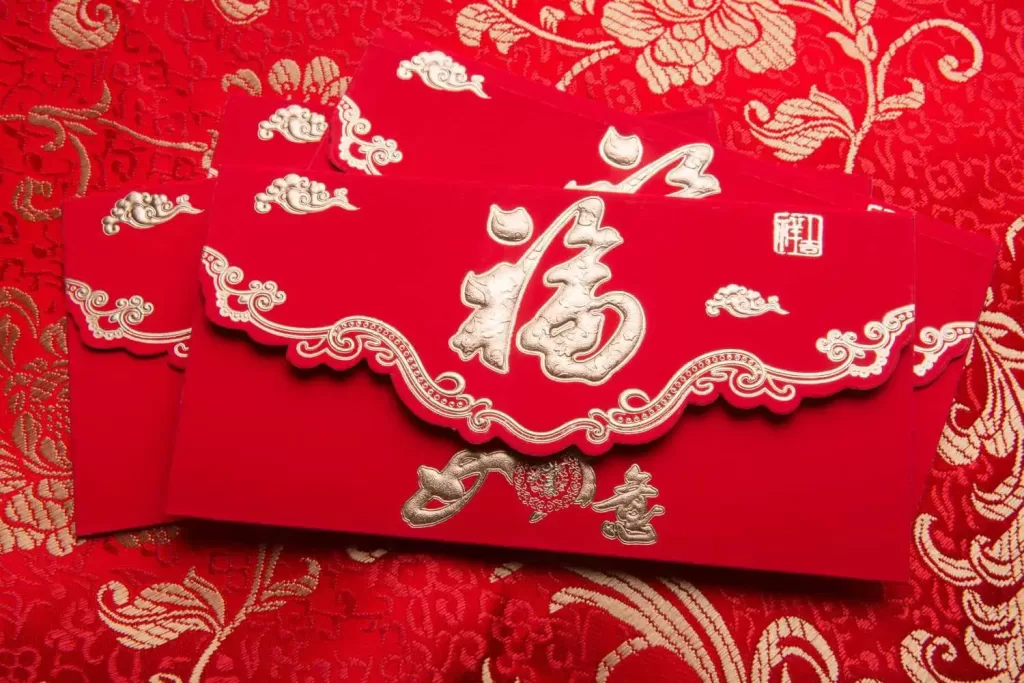
- Traditional Chinese: 紅包
- Simplified Chinese: 红包
- English: Red Envelope
Cantonese 利是 (lai6 si6)
Mandarin (hóng bāo)
In Chinese culture, red envelopes symbolize luck and prosperity, warding off evil spirits and bringing fortune. During Chinese New Year, giving red envelopes shares blessings and well-wishes with loved ones, bringing joy and spreading good wishes.
13. Fireworks | 煙花
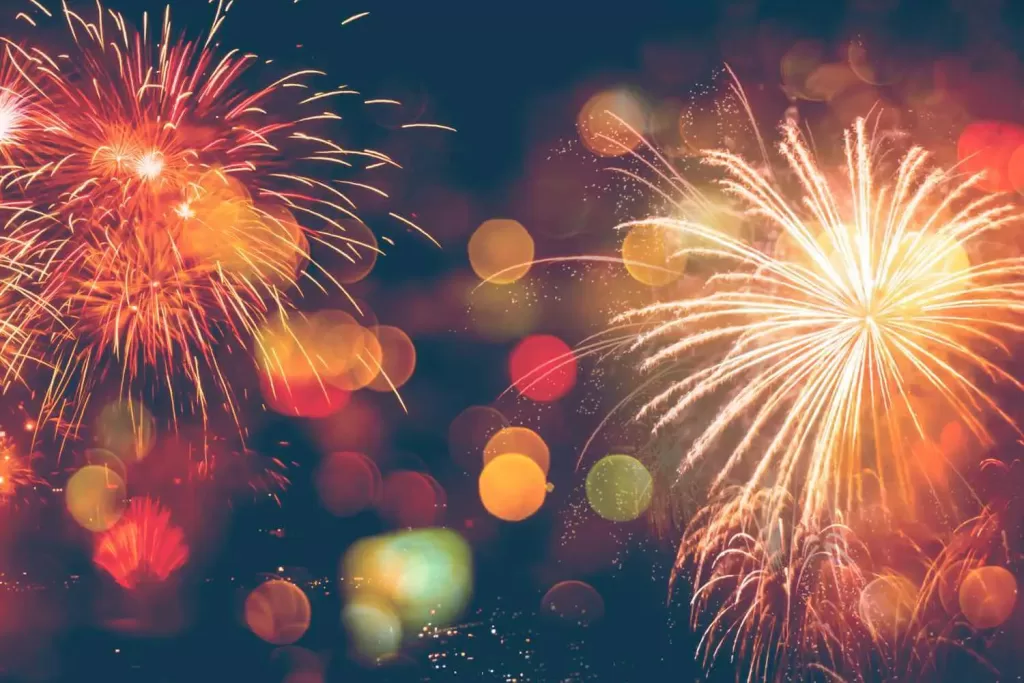
- Traditional Chinese: 煙花
- Simplified Chinese: 烟花
- English: Fireworks
Cantonese (jin1 faa1)
Mandarin (yān huā)
During Chinese New Year, fireworks are used to scare away bad luck and bring good fortune. In ancient times, firecrackers were believed to drive away evil spirits. Today, watching fireworks is a joyful activity that brings friends and family together to celebrate.
14. Firecrackers | 鞭炮
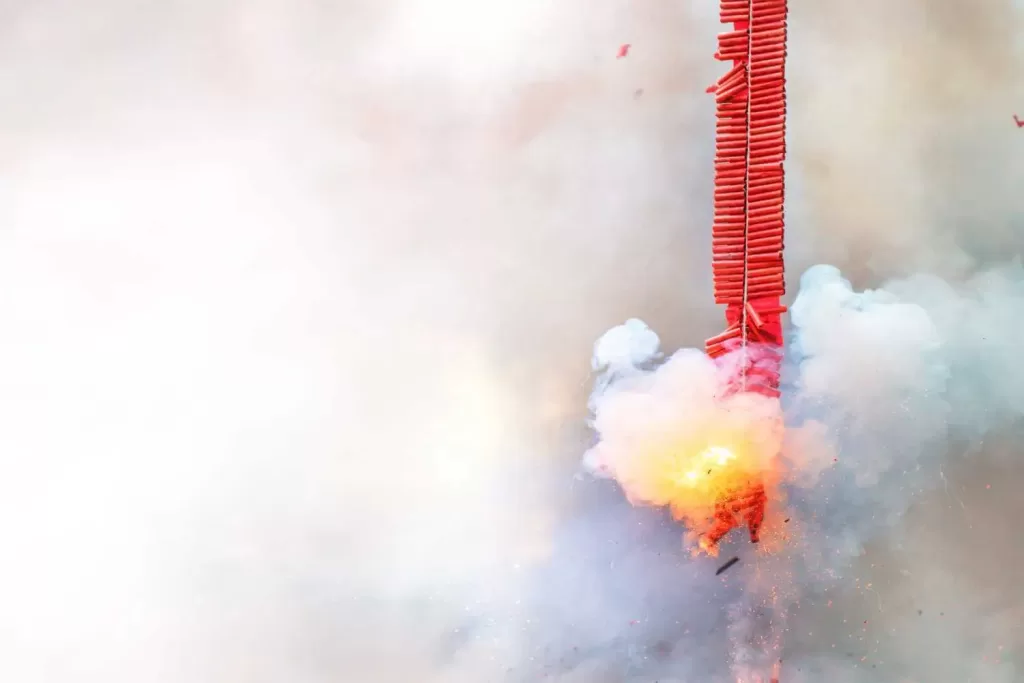
- Traditional Chinese: 鞭炮
- Simplified Chinese: 鞭炮
- English: Firecrackers
Cantonese (bin1 paau3)
Mandarin (biān pào)
Firecrackers are a traditional part of Chinese New Year celebrations, believed to ward off bad spirits and bring good luck. While safety concerns have led to the use of electronic firecrackers in some places, they remain an important symbol of celebrating the new year and attracting good fortune.
15. Lantern | 燈籠
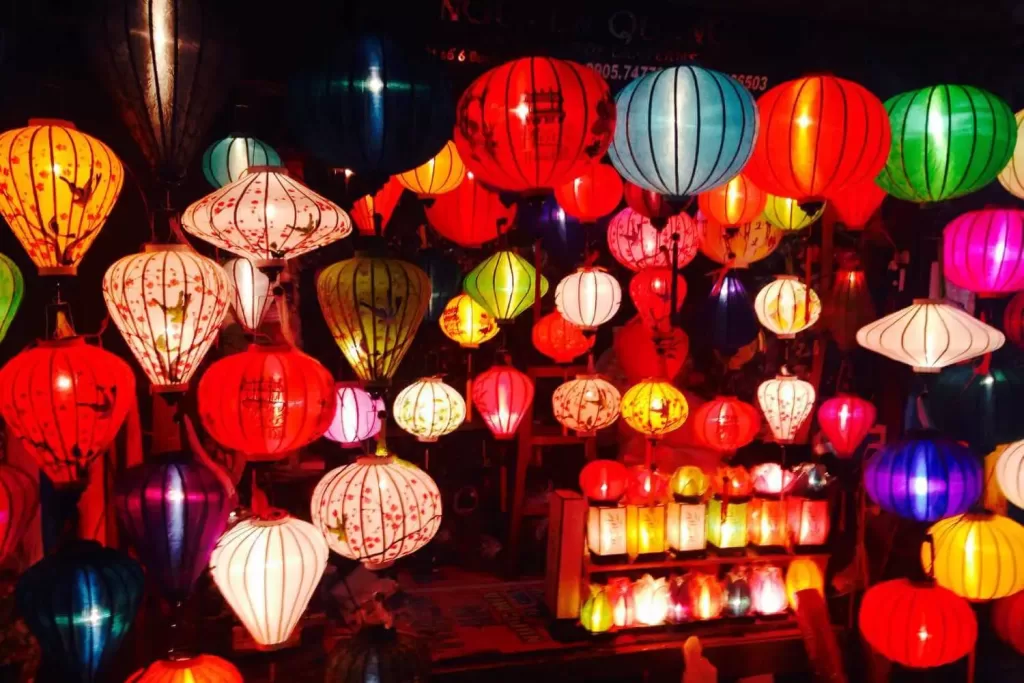
- Traditional Chinese: 燈籠
- Simplified Chinese: 灯笼
- English: Lantern
Cantonese (dang1 lung4)
Mandarin (dēng lóng)
Lanterns are a traditional decoration for Chinese New Year, symbolizing hope and good luck. They come in various shapes and sizes, with some featuring Chinese characters or designs related to the zodiac animal of the year. Lanterns are also used during lantern festivals, which take place on the 15th day of Chinese New Year.
16. Dragon Dance | 舞龍
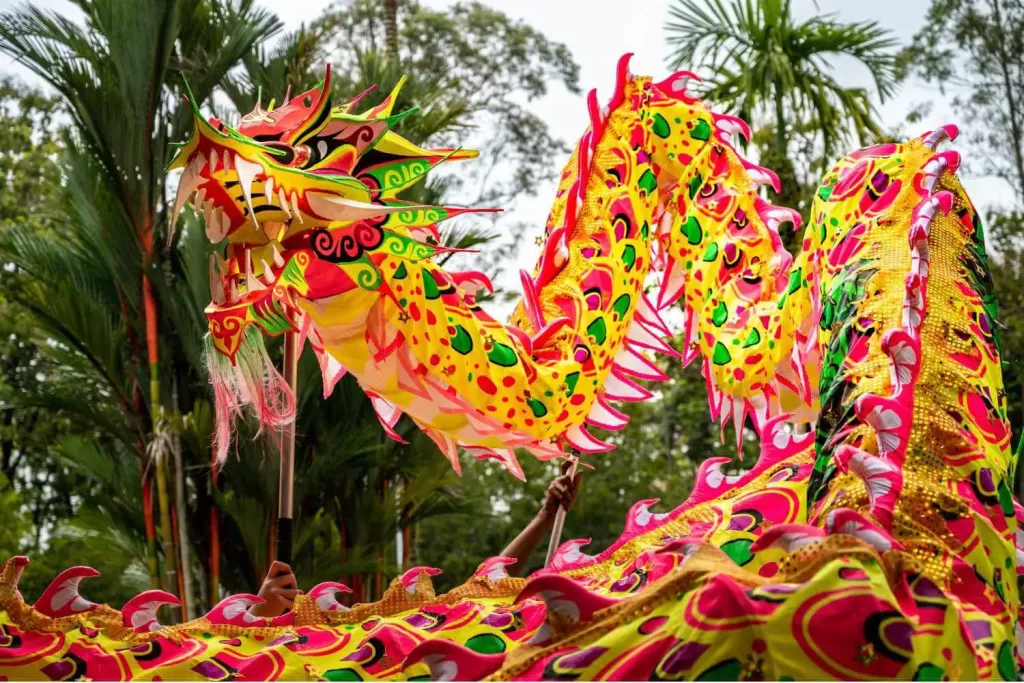
- Traditional Chinese: 舞龍
- Simplified Chinese: 舞龙
- English: Dragon Dance
Cantonese (mou5 lung4)
Mandarin (wǔ lóng)
The dragon dance is a popular performance during Chinese New Year celebrations, where a long dragon made of cloth and paper is maneuvered by a group of performers. The dragon represents power, strength, and good luck. It is believed that the longer the dragon, the more luck it will bring for the new year.
17. Lion Dance | 舞獅
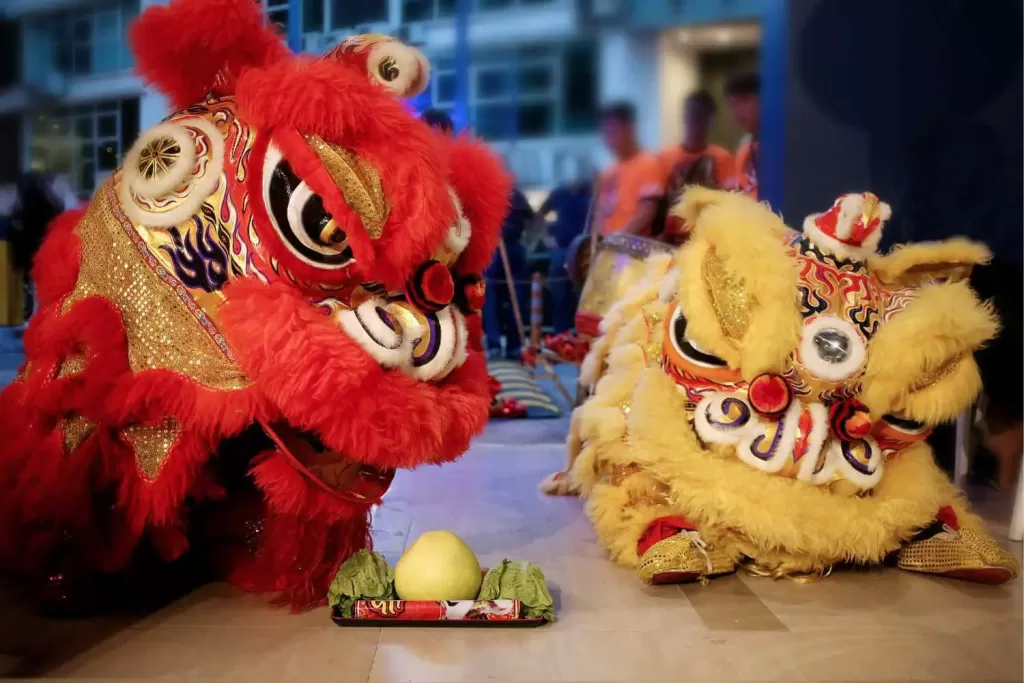
- Traditional Chinese: 舞獅
- Simplified Chinese: 舞狮
- English: Lion Dance
Cantonese (mou5 si1)
Mandarin (wǔ shī)
The lion dance is a traditional Chinese New Year performance where dancers in a lion costume mimic its movements to the beat of drums and cymbals. Symbolizing courage, strength, and good luck, the dance aims to ward off evil spirits and bring prosperity for the new year.
18. Zodiac Animals | 十二生肖
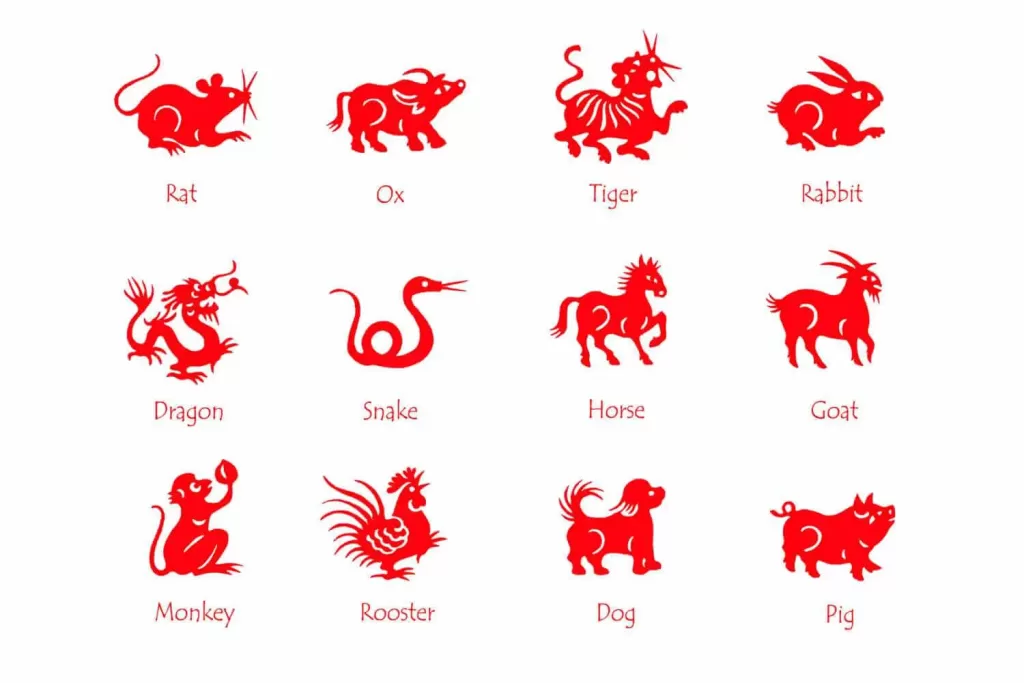
- Traditional Chinese: 十二生肖
- Simplified Chinese: 十二生肖
- English: Zodiac Animals
Cantonese (sap6 ji6 sang1 ciu3)
Mandarin (shí èr shēng xiāo)
The Chinese zodiac follows a 12-year cycle, with each year symbolized by an animal. These animals, such as the rat, ox, and tiger, are believed to have a profound impact on one's personality and destiny. Many Chinese individuals wear accessories or clothing representing their zodiac animal to attract luck and good fortune.
Check out our 12 free zodiac animals worksheet printables for kids.
19. Spring Couplets | 春聯
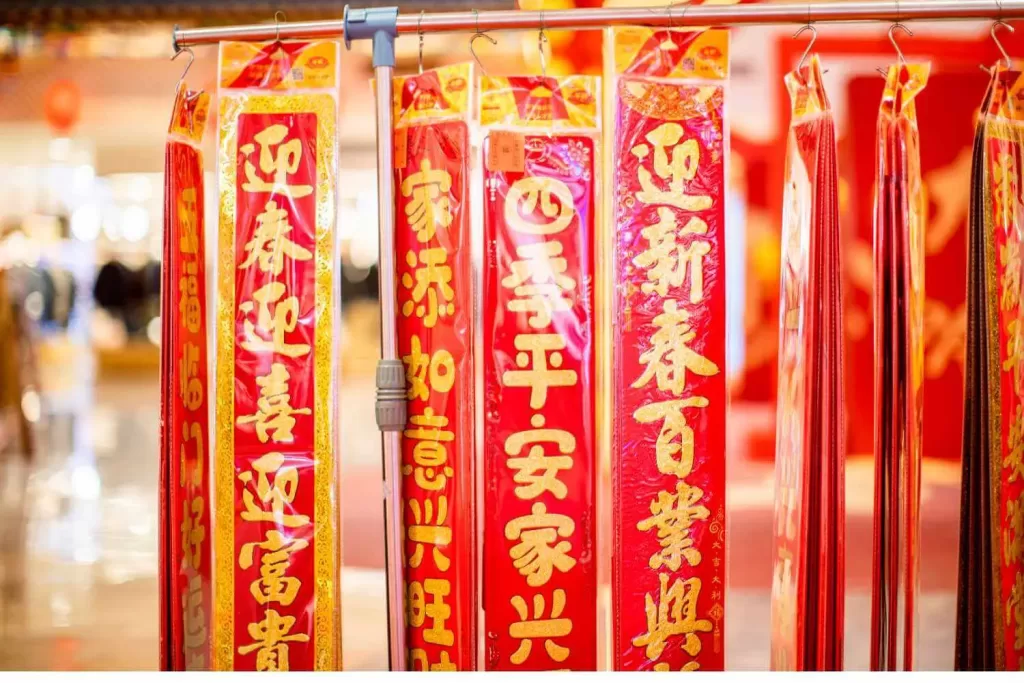
- Traditional Chinese: 春聯
- Simplified Chinese: 春联
- English: Spring Couplets
Cantonese 揮春 (fai1 ceon1)
Mandarin (chūn lián)
Spring couplets are poetic lines written on red paper and hung on doors during Chinese New Year. They contain auspicious phrases and wishes for prosperity, good luck, and success. This tradition is believed to bring blessings and ward off negative energy.
Check out our free spring couplet printables with stroke order guidance!
20. Festive Decorations | 賀年裝飾
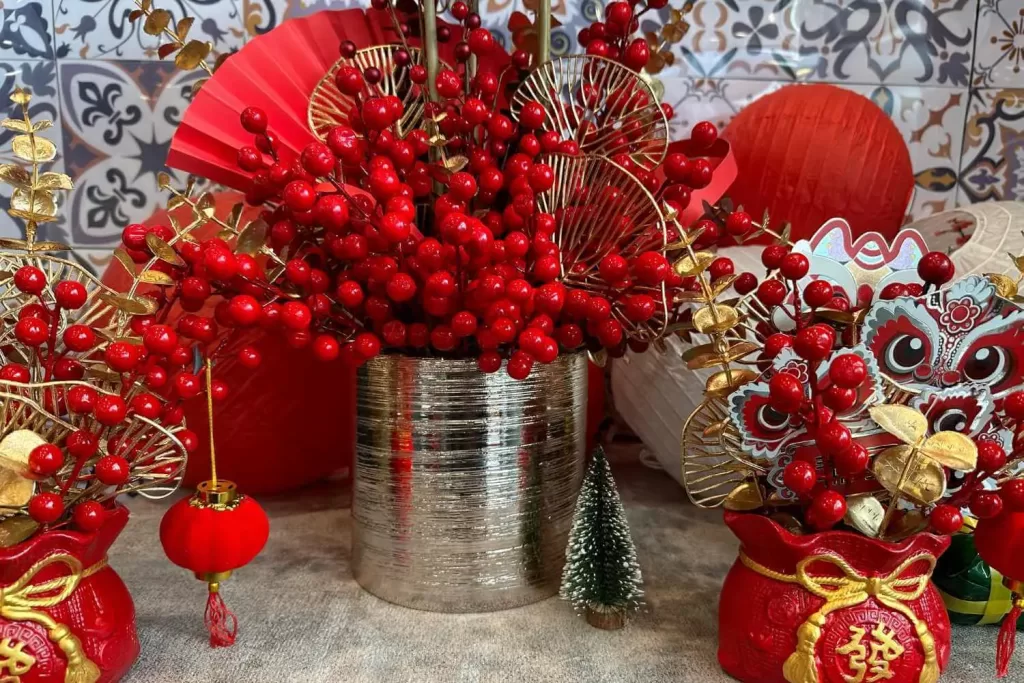
- Traditional Chinese: 賀年裝飾
- Simplified Chinese: 贺年装饰
- English: Festive Decorations
Cantonese (ho4 nin4 zong1 sik1)
Mandarin (hè nián zhuāng shì)
During Chinese New Year, streets and homes are adorned with festive decorations such as lanterns, paper cuttings, and red banners. These decorations symbolize prosperity, good fortune, and happiness for the new year. Many families also display orange or tangerine trees to represent abundance and wealth.
Check out 10 Chinese New Year Decoration Ideas to Bring Luck to Your Home from Bilingual Kidspot.
21. Parade of Floats |
- Traditional Chinese: 花車巡遊
- Simplified Chinese: 花车巡游
- English: Parade of Floats
Cantonese (faa1 ce1 ceon4 jau4)
Mandarin (huā chē xún yóu)
A highlight of Chinese New Year celebrations, the parade of floats features elaborate and colorful designs representing different cultural elements. These floats often depict scenes from Chinese mythology or zodiac animals and are accompanied by traditional music and dancing performances.
22. Prayers and Worship | 祈福祭拜
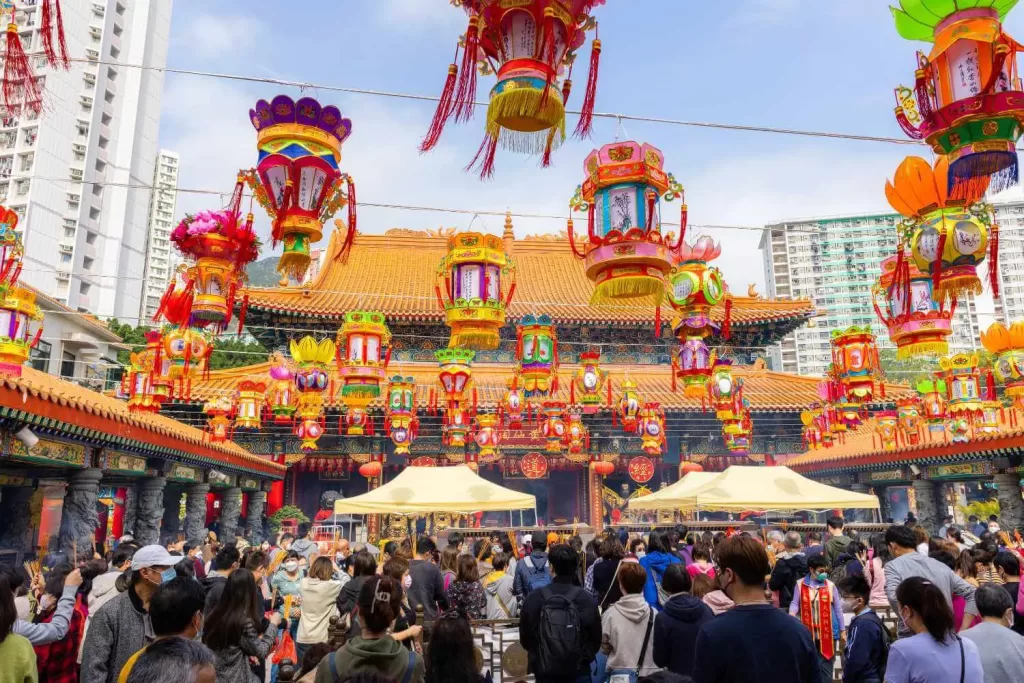
- Traditional Chinese: 祈福祭拜
- Simplified Chinese: 祈福祭拜
- English: Prayers and Worship
Cantonese (kei4 fuk1 zai3 baai3)
Mandarin (qí fú jì bài)
During Chinese New Year, many people visit temples and offer prayers and incense to deities for blessings and protection in the upcoming year. People also pay respects to ancestors by offering food and burning incense at home altars or gravesites. These rituals are believed to bring good luck and prosperity for the new year.
23.Wishing Tree | 許願樹

- Traditional Chinese: 許願樹
- Simplified Chinese: 许愿树
- English: Wishing Trees
Cantonese (heoi2 jyun6 syu6)
Mandarin (xǔ yuàn shù)
Wishing trees are a popular tradition during Chinese New Year where people write their wishes on red paper and tie them onto branches. This practice is believed to bring good luck and help make the wishes come true in the upcoming year. It's a fun and meaningful way to express hopes and dreams for the new year.
24. Peach Blossoms | 桃花
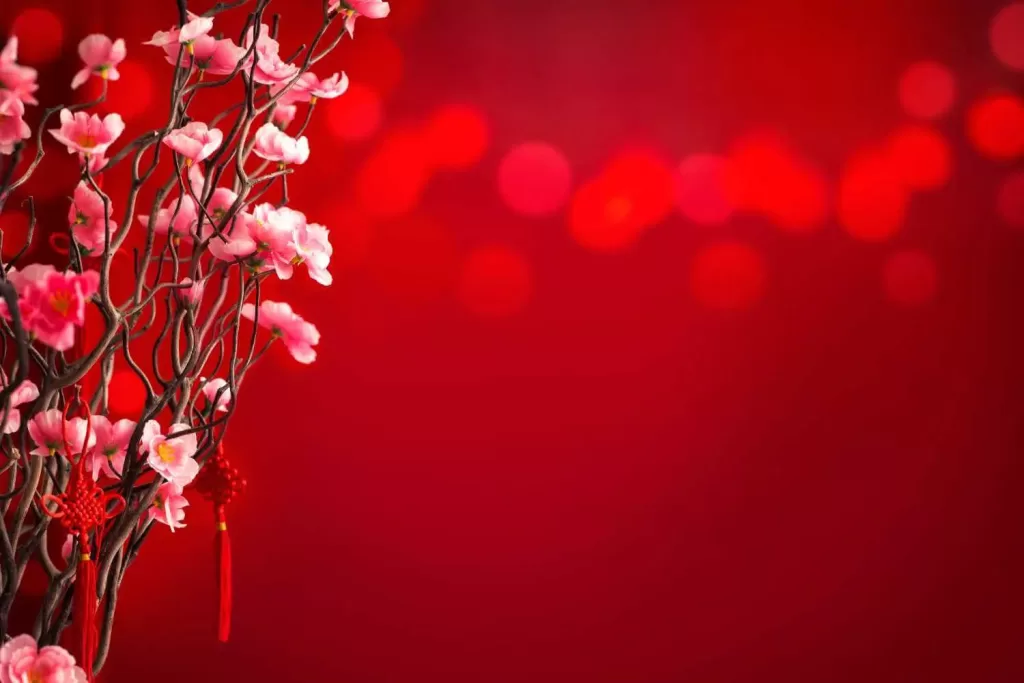
- Traditional Chinese: 桃花
- Simplified Chinese: 桃花
- English: Peach Blossoms
Cantonese (tou4 faa1)
Mandarin (táo huā)
Peach blossoms are a symbol of luck and prosperity in Chinese culture, especially during Chinese New Year. These beautiful pink flowers are often seen in decorations and clothing and are believed to bring good fortune and happiness for the new year. It's also a popular flower used by singles looking for love as it symbolizes romance and marriage luck.
25.Water Fairy Flowers | 水仙花
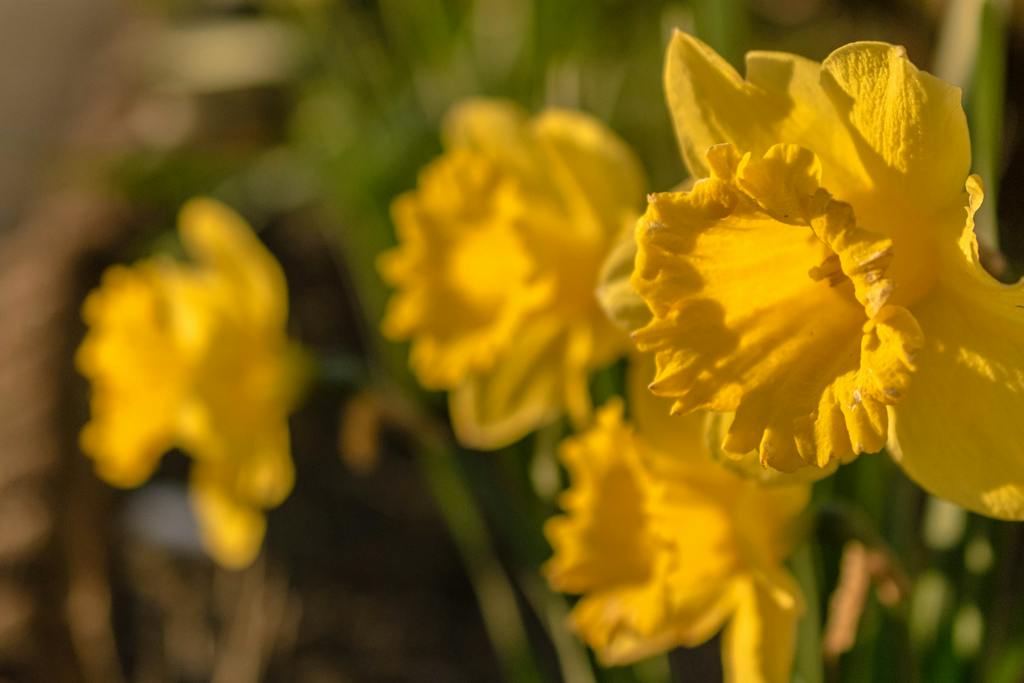
- Traditional Chinese: 水仙花
- Simplified Chinese: 水仙花
- English: Narcissus Flowers
Cantonese (seoi2 sin1 faa1)
Mandarin (shuǐ xiān huā)
Water fairy flowers, also known as narcissus flowers, symbolize good luck and prosperity during Chinese New Year. These white and yellow flowers are believed to bring wealth and success in the upcoming year, adding beauty and symbolism to the festive atmosphere.
26. Gifts | 禮物
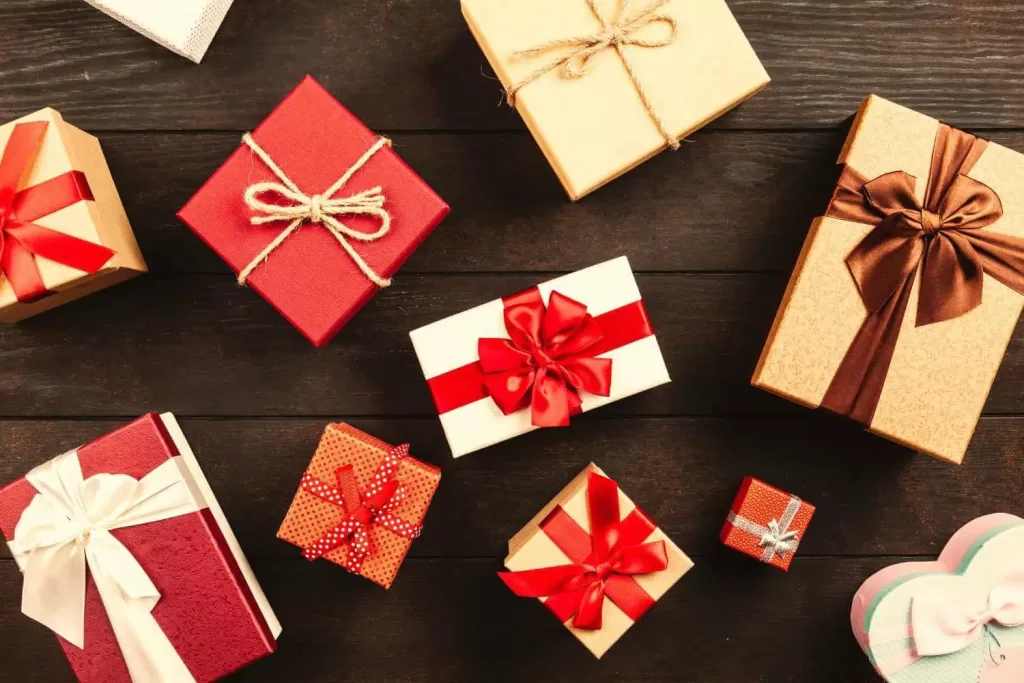
- Traditional Chinese: 禮物
- Simplified Chinese: 礼物
- English: Gifts
Cantonese (lai5 mat6)
Mandarin (lǐ wù)
Giving gifts is an important tradition during Chinese New Year as it symbolizes respect, gratitude, and good wishes for the recipient. Common gifts include red envelopes with money, food items such as candies and fruits, and small trinkets or souvenirs. The act of giving and receiving gifts is a way to show appreciation for relationships and bring blessings for the new year.
27. Tangerine Tree | 年桔
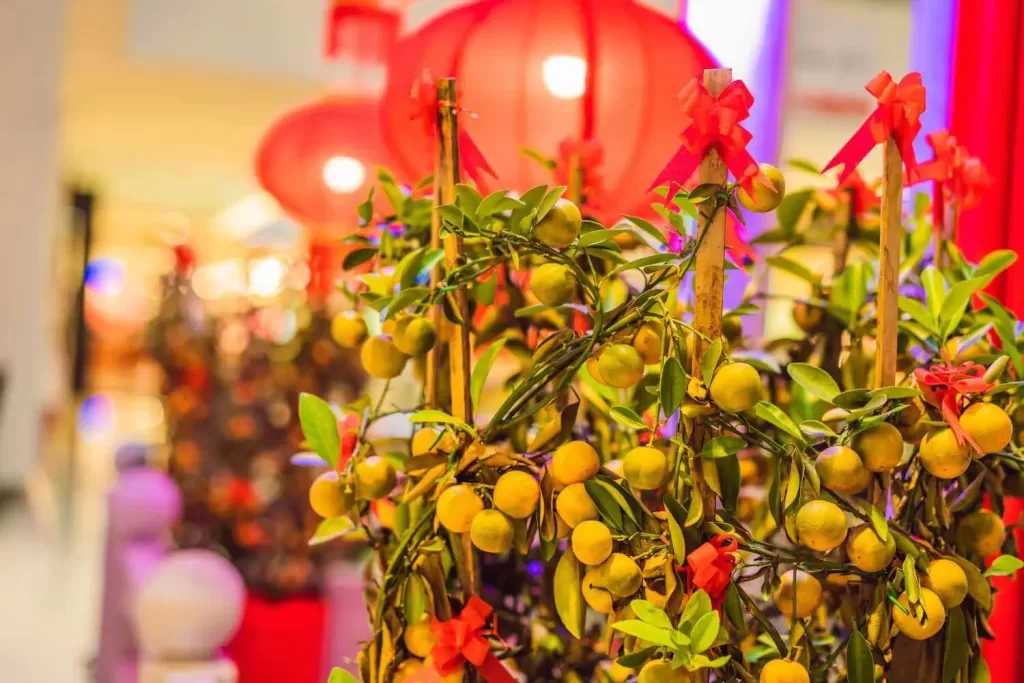
- Traditional Chinese: 年桔
- Simplified Chinese: 年桔
- English: Tangerine Tree
Cantonese (nin4 gat1)
Mandarin (nián jú)
Tangerines are a must-have fruit during Chinese New Year as they represent good luck and wealth. The tangerine tree, also known as the tangerine plant or kumquat tree, is often seen in homes and businesses during this time. Its round shape and golden color symbolize fullness and prosperity for the new year. Eating tangerines is believed to bring good fortune and sweetness into one's life.
Chinese New Year Food
28. Dumplings | 餃子
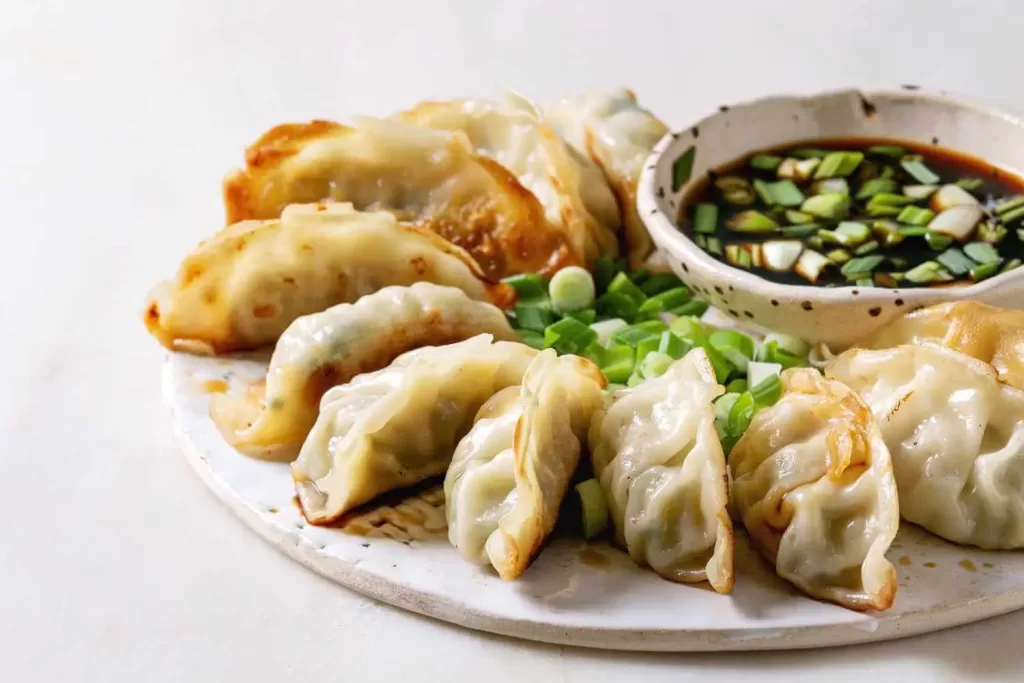
- Traditional Chinese: 餃子
- Simplified Chinese: 饺子
- English: Dumplings
Cantonese (gaau2 zi2)
Mandarin (jiǎo zi)
A must-have dish during Chinese New Year, dumplings symbolize wealth and good luck due to their shape resembling ancient Chinese gold and silver ingots. Families often gather together to make dumplings on New Year's Eve, filling them with various ingredients such as pork, shrimp, or vegetables. They are usually boiled or pan-fried and served with a dipping sauce.
Check out 10 Chinese Dumpling Recipes for Chinese New Year from Omnivore's Cookbook.
29. Longevity Noodles | 長壽麵
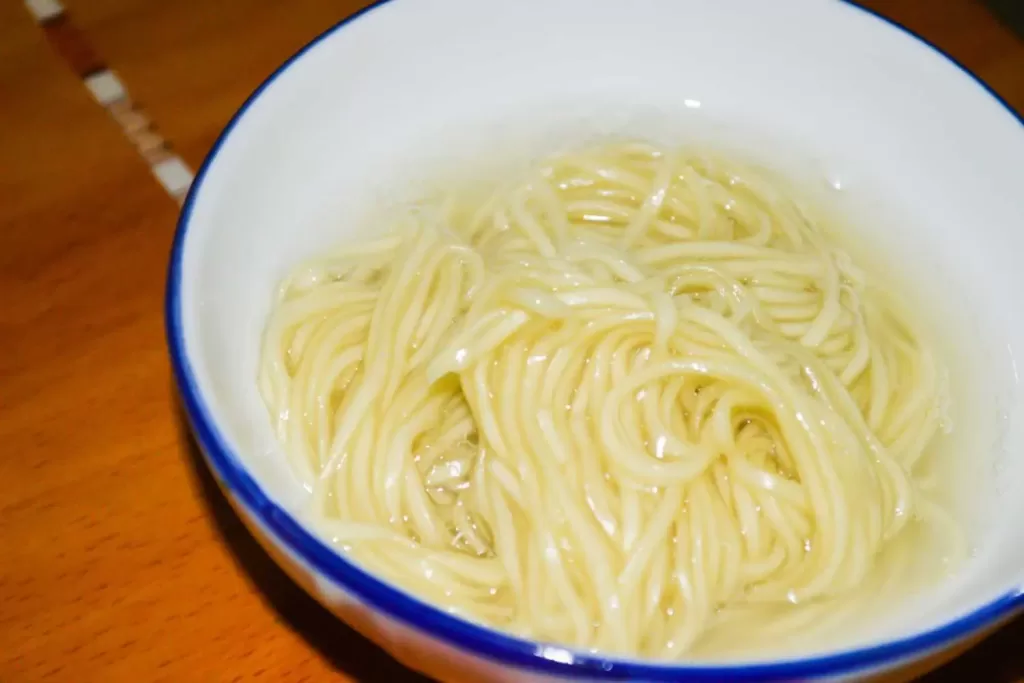
- Traditional Chinese: 長壽麵
- Simplified Chinese: 长寿面
- English: Longevity Noodles
Cantonese (coeng4 sau6 min6)
Mandarin (cháng shòu miàn)
These long, uncut noodles symbolize a wish for longevity and are commonly served during Chinese New Year. It is believed that the longer the noodle, the longer one's life will be. The noodles are typically stir-fried and can be topped with various meats and vegetables.
30. Nian Gao | 年糕
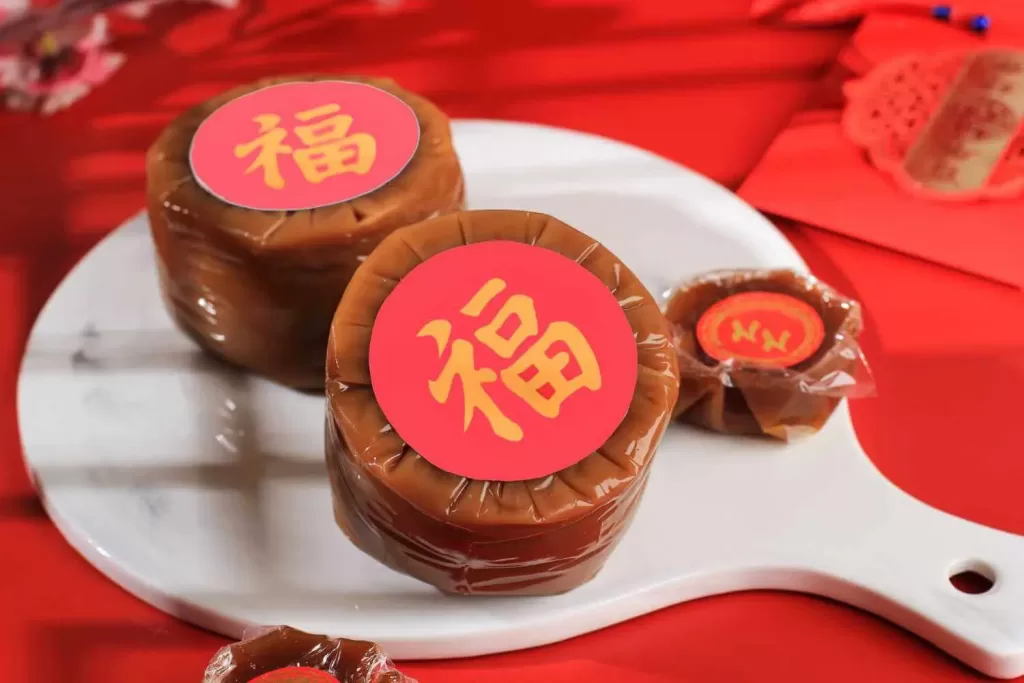
- Traditional Chinese: 年糕
- Simplified Chinese: 年糕
- English: Nian Gao
Cantonese (nin4 gou1)
Mandarin (nián gāo)
Nian gao, also known as sticky rice cake, is a popular Chinese New Year dessert. It's made from glutinous rice flour and sugar, giving it a sticky and chewy texture. The Chinese word for “sticky” is a homophone for the word “year,” symbolizing the wish for prosperity and progress in the upcoming year. Nian gao can be steamed, fried, or stir-fried with vegetables and meat for a savory dish.
Check out the Coconut Rice Cake Recipe from Spot of Sunshine.
31. Candied Fruits | 糖果

- Traditional Chinese: 糖果
- Simplified Chinese: 糖果
- English: Candied Fruits
Cantonese (tong4 gwo2)
Mandarin (táng guǒ)
Candied fruits, also known as tanghulu in Chinese, are a popular snack during Chinese New Year celebrations. They are made by dipping fruits such as hawthorn berries or mandarin oranges into melted sugar syrup and letting it harden. The sweet and crunchy treat symbolizes a sweet and prosperous year ahead.
32. Fish | 魚
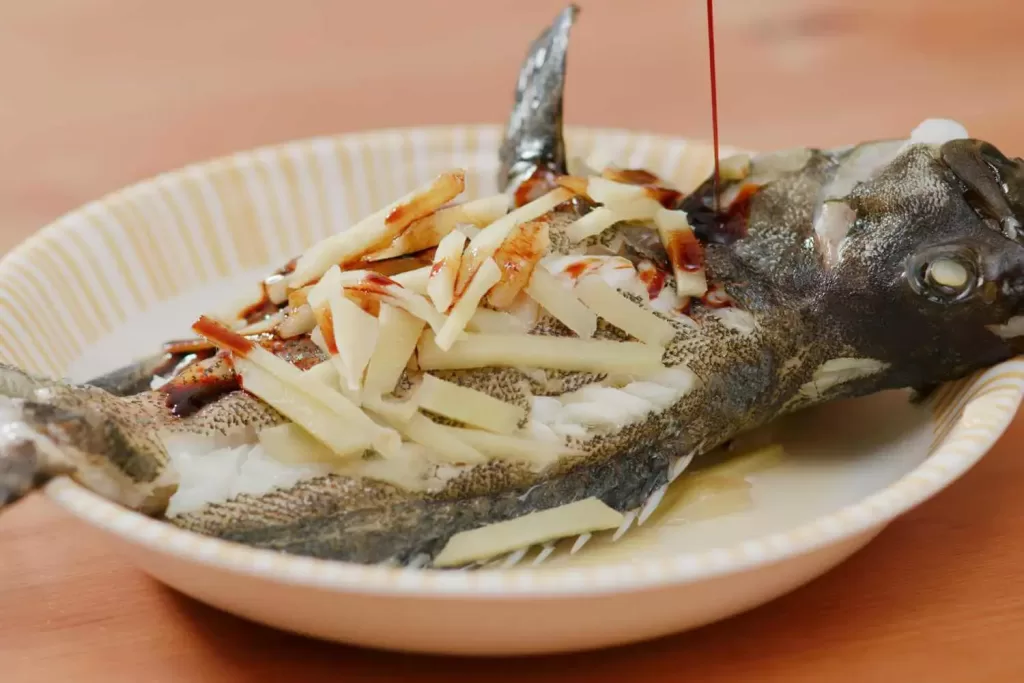
- Traditional Chinese: 魚
- Simplified Chinese: 鱼
- English: Fish
Cantonese (jyu4)
Mandarin (yú)
Fish is a significant dish during Chinese New Year celebrations. It symbolizes surplus and abundance, often served whole to represent a good beginning and end.
Check out the Chinese Steamed Fish recipe from Tiffy Cooks.
33. Glutinous Rice Balls | 湯圓
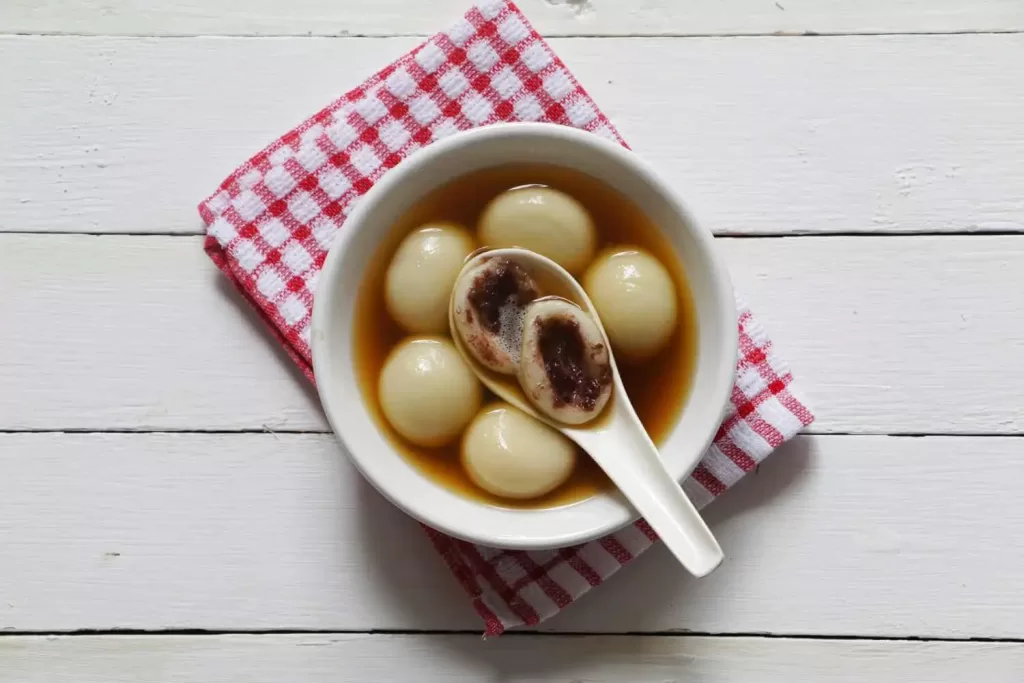
- Traditional Chinese: 湯圓
- Simplified Chinese: 汤圆
- English: Glutinous Rice Balls
Cantonese (tong1 jyun4)
Mandarin (tāng yuán)
Glutinous rice balls, also known as tangyuan, are popular during Chinese New Year. These small round balls are filled with sweet fillings like red bean paste, symbolizing unity and harmony in the family. Enjoyed in a sweet syrup soup, they are a delicious and meaningful tradition.
34. Pomelo | 柚子

- Traditional Chinese: 柚子
- Simplified Chinese: 柚子
- English: Pomelo
Cantonese (jau2 zi2)
Mandarin (yòu zi)
Pomelos, also known as Chinese grapefruit, is a popular fruit during Chinese New Year. Its round shape and golden color symbolize fullness and wealth for the new year. It is often given as a gift or used in festive dishes like pomelo salad, combining its sweet and sour flavor with other ingredients for a refreshing dish.
35. Chocolate coin | 巧克力金幣

- Traditional Chinese: 巧克力金幣
- Simplified Chinese: 巧克力金币
- English: Chocolate coin
Cantonese 朱古力(zyu1 gu1 lik1 gam1 bai6)
Mandarin (qiǎo kè lì jīn bì)
Chocolate coins, also known as lucky money or red envelopes, are a popular gift during Chinese New Year. They symbolize good luck and prosperity and add a fun and festive touch to the holiday celebrations. Spread joy and luck this Chinese New Year with delicious chocolate coins!
36. Tray of Togetherness | 攢盒
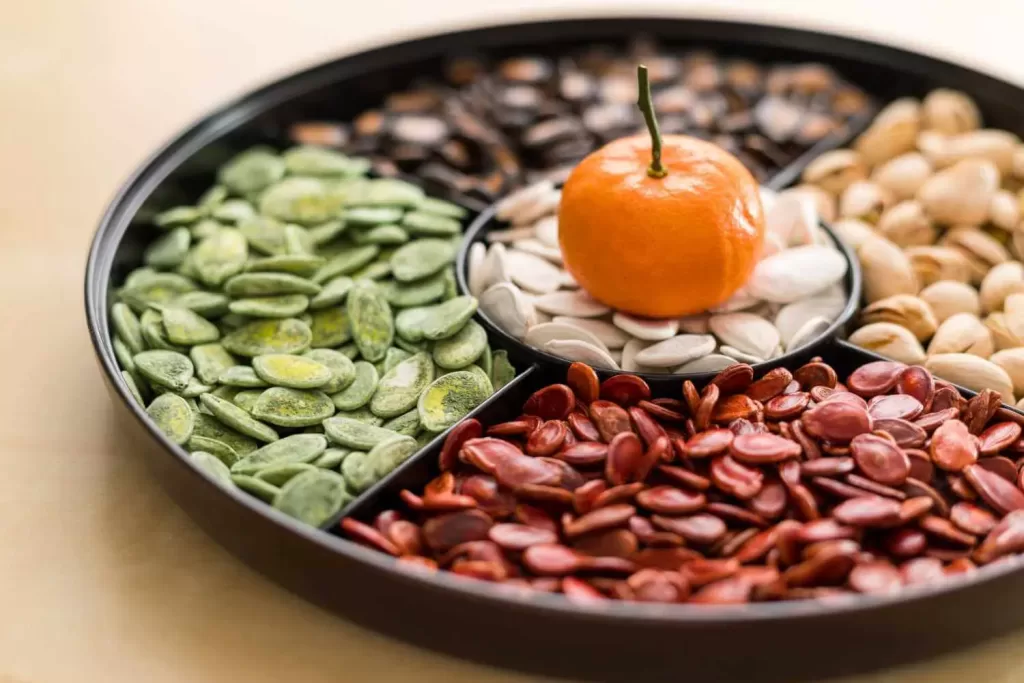
- Traditional Chinese: 攢盒
- Simplified Chinese: 攒盒
- English: Tray of Togetherness
Cantonese (cyun4 hap6)
Mandarin (cuán hé)
The Candy box, also known as the tray of togetherness, is a common sight during Chinese New Year celebrations. It is filled with traditional sweets and snacks symbolizing good luck and prosperity, making it a meaningful and delicious part of the holiday festivities.
37. Crispy Pastry Dumpling | 角仔
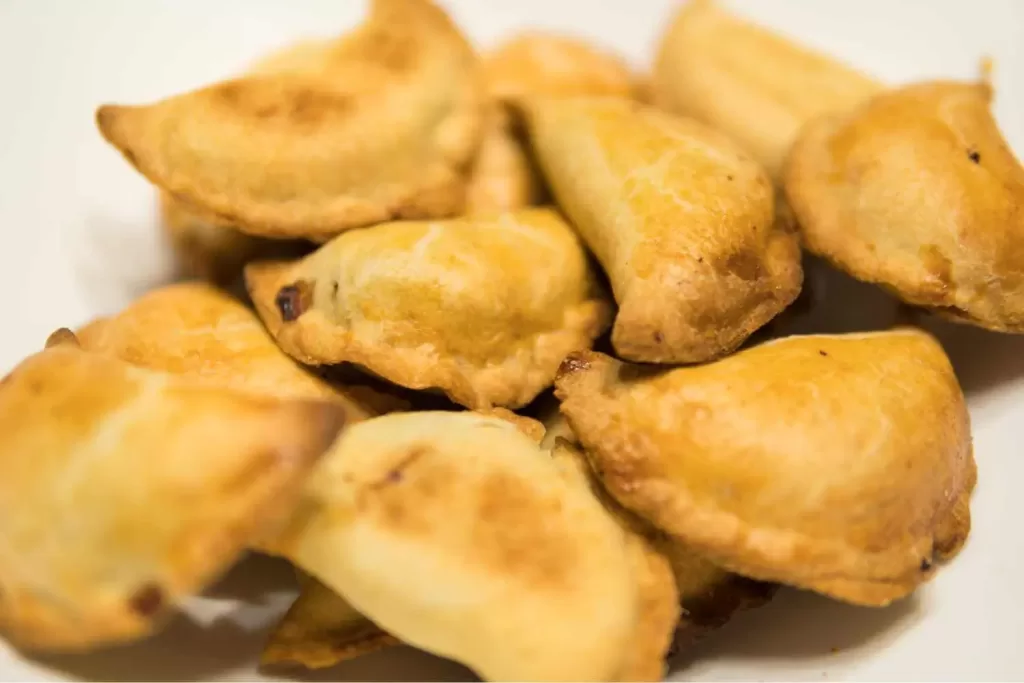
- Traditional Chinese: 角仔
- Simplified Chinese: 角仔
- English: Crispy pastry dumpling
Cantonese (gok3 zai2)
Mandarin (jiǎo zǐ)
Yau gok or Jau gok is a traditional dumpling recipe found in Cantonese cuisine, originating from the Guangdong Province in China. They are most commonly prepared during Chinese New Year and enjoyed in Cantonese-speaking regions and communities, including Hong Kong and Malaysia. Give it a try during the festive season and savor the delicious flavors of this Cantonese delicacy!
Try to make this using Hong Kong Cookery's recipe.
38. Laughing Sesame Balls 笑口棗
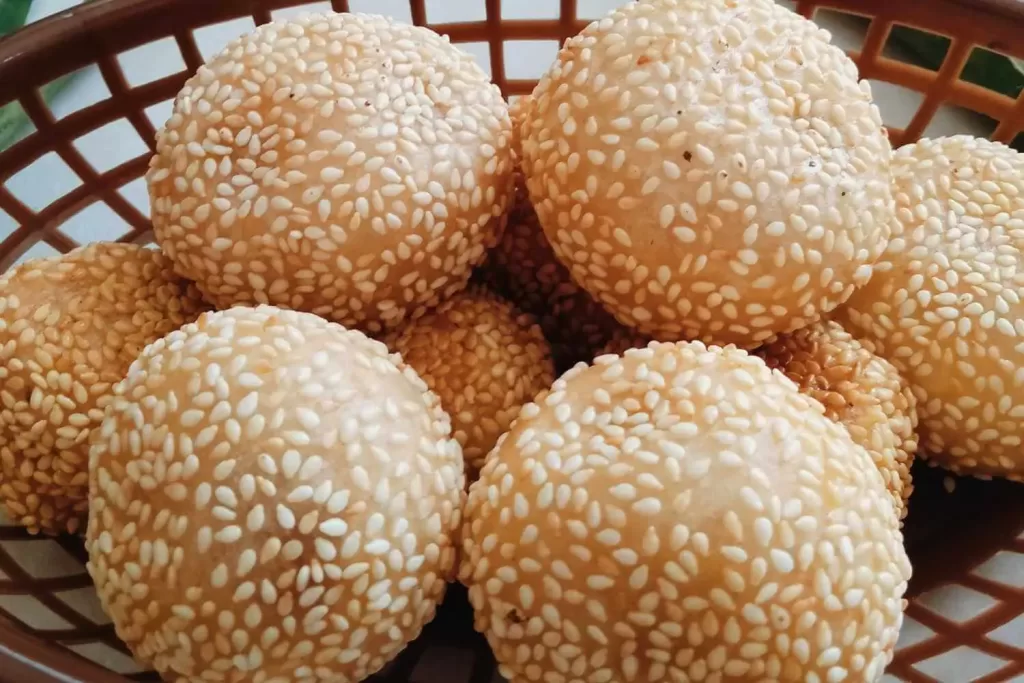
- Traditional Chinese: 笑口棗
- Simplified Chinese: 笑口枣
- English: Sesame Balls
Cantonese (siu3 hau2 zou2)
Mandarin (xiào kǒu zǎo)
Sesame Cookie Balls, also known as laughing or smiling sesame balls, are no different. When these sesame cookie balls are deep-fried, the natural cracks on them resemble happy faces, which is why they're called smiling sesame cookie balls. They're super fun and delicious!
Check out the Laughing Sesame Balls recipe from Auntie Emily.
More Chinese New Year Resources
Check out these Chinese New Year resources:

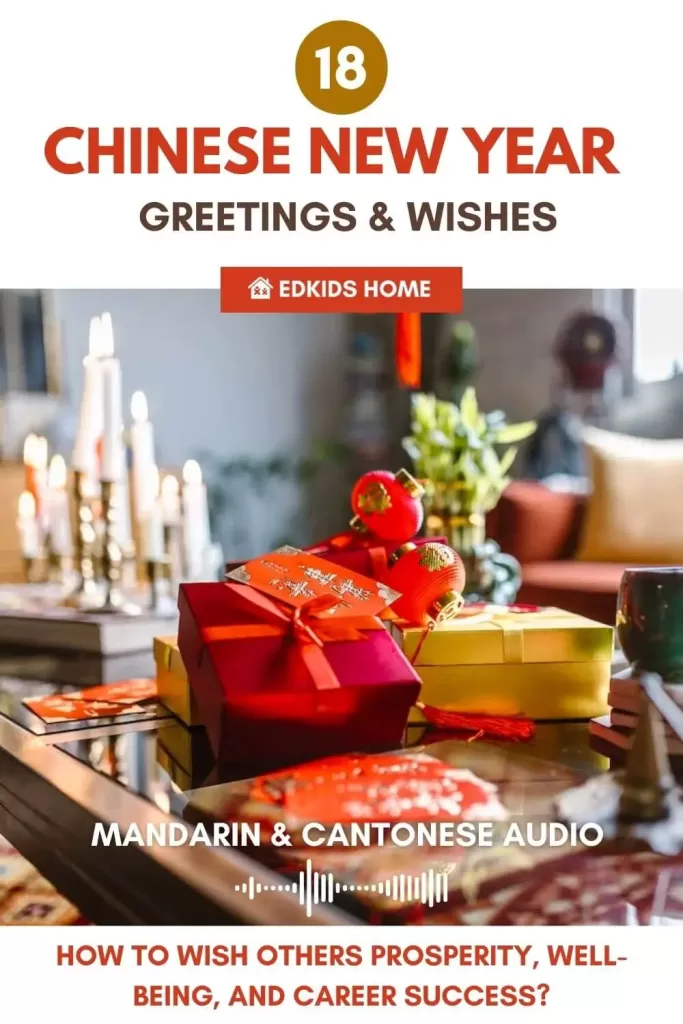
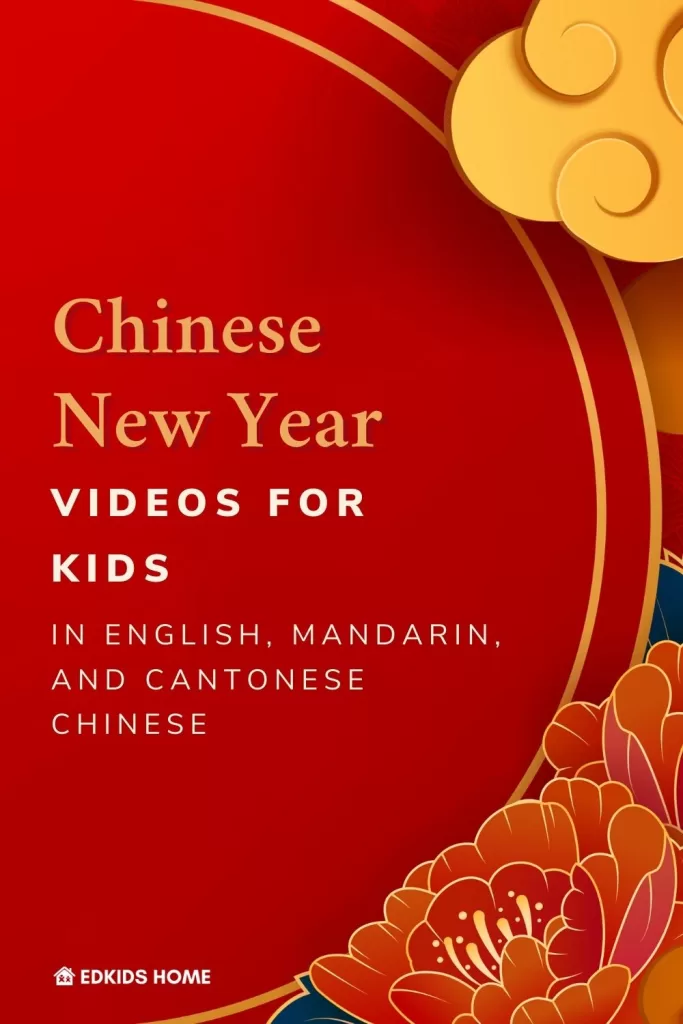
Last Thing About Chinese New Year Vocabulary
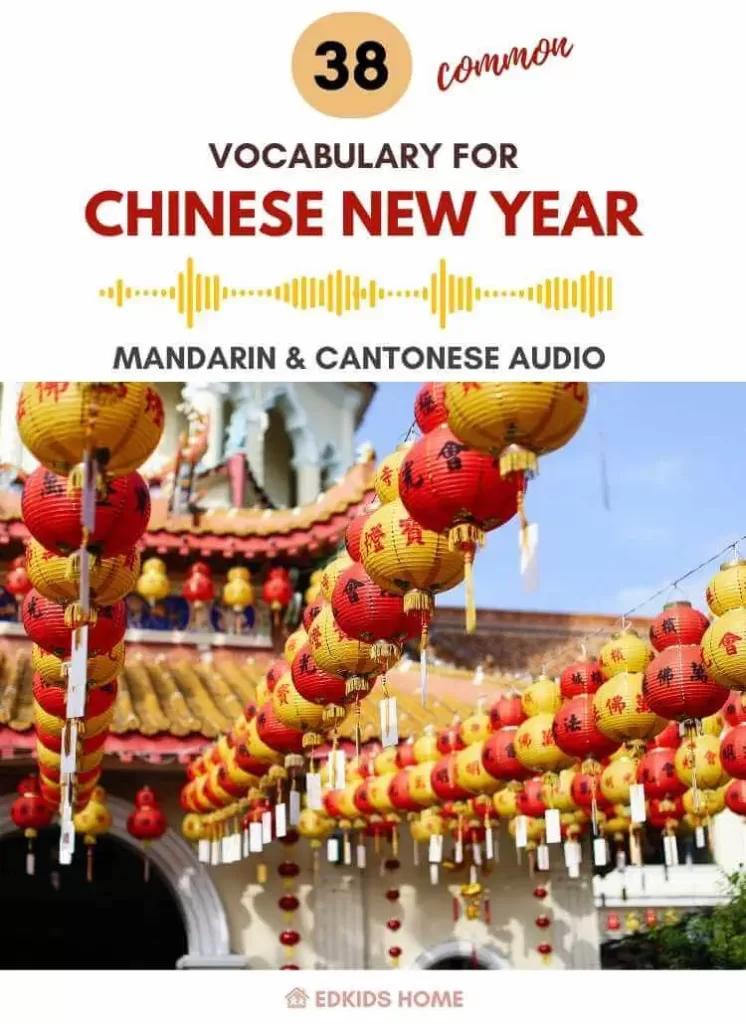
In conclusion, Chinese New Year isn't just about celebrating a new year. It's a super cool cultural event with awesome traditions and delicious food. Each dessert and dish has a deeper meaning, like bringing prosperity and spreading joy and laughter. By checking out these 38 Chinese New Year vocabulary terms, we can appreciate this lively festival and its customs. So, whether it's the sesame balls or the crispy pastry dumpling, make sure to enjoy these treats and the rich traditions they represent in the upcoming Chinese New Year!
